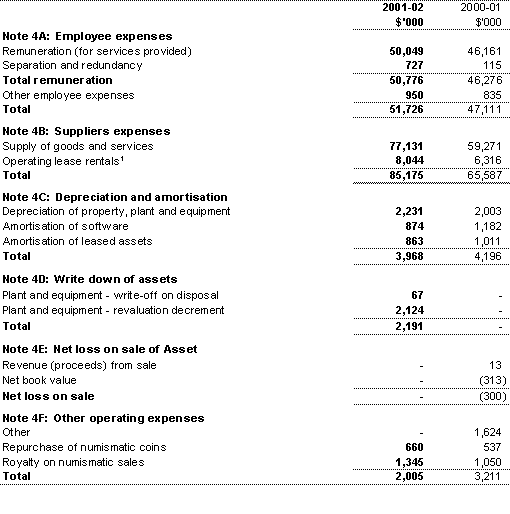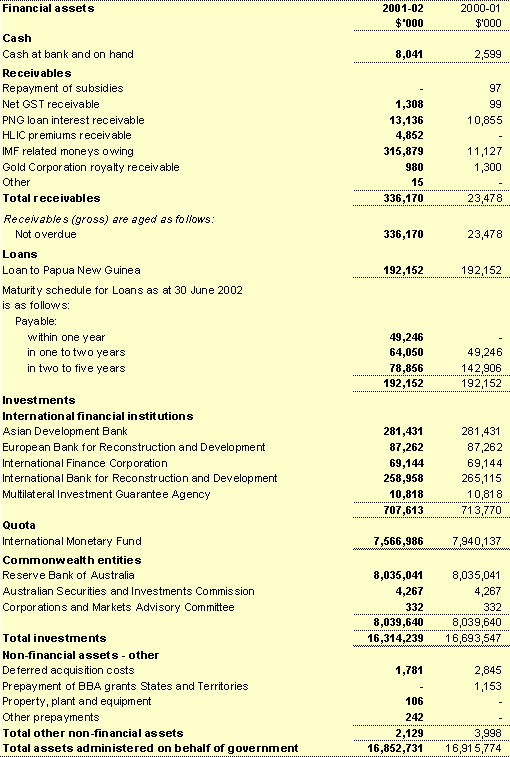Certification of financial statements
Department of the Treasury statement of financial performance
Department of the Treasury statement of financial position
Department of the Treasury statement of cash flows
Schedule of unquantifiable contingencies
Notes to and forming part of the financial statements
Audit Report
Department of the Treasury
statement by the Departmental Secretary
Certification of financial statements
In my opinion, the attached financial statements for the year ended 30 June 2002 give a true and fair view of the matters required by the Finance Minister's Orders made under the Financial Management and Accountability Act 1997.
Ken Henry
Secretary to the Treasury
16 September 2002
Department of the Treasury statement of financial performance
for the year ended 30 June 2002

The above statement should be read in conjunction with the accompanying notes.
Department of the Treasury statement of financial position
as at 30 June 2002
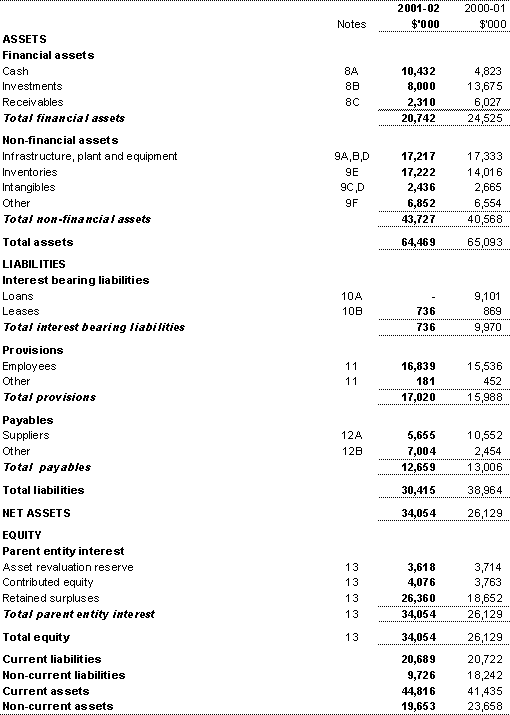
The above statement should be read in conjunction with the accompanying notes.
Department of the Treasury statement of cash flows
for the year ended 30 June 2002
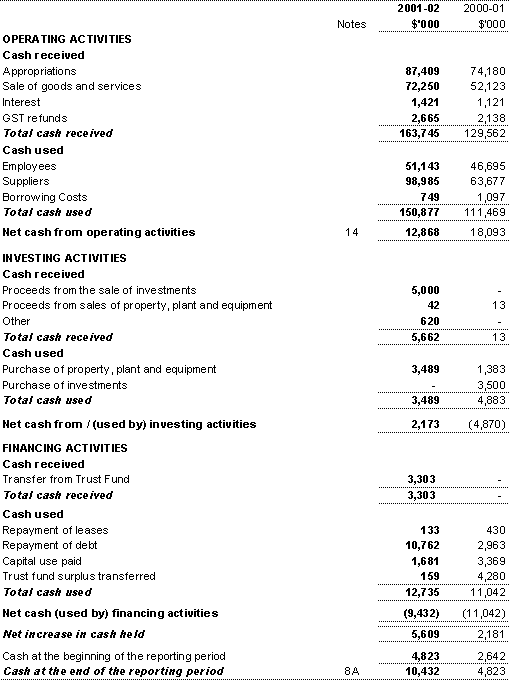
The above statement should be read in conjunction with the accompanying notes.
Schedule of commitments
as at 30 June 2002
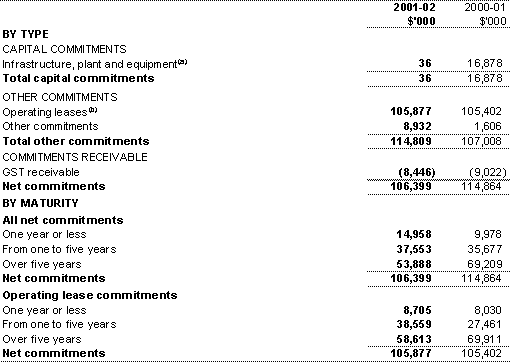
(a) Plant and equipment commitments are primarily for purchases of furniture and fittings for building refurbishment.
(b) Operating leases included cannot be cancelled and comprise the following:
|
Nature of lease |
General description of leasing arrangement |
|
1. Leases for accommodation |
|
|
2. Agreements for the provision of motor vehicles to Senior Executive Officers |
|
|
3. Leases for computer equipment |
|
Note: All 2001-02 commitments are GST inclusive where relevant.
The above schedules should be read in conjunction with the accompanying notes.
Schedule of contingencies
as at 30 June 2002
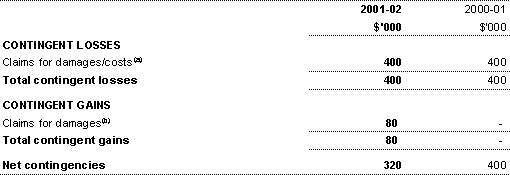
(a) The amount represents an estimate of the department's liability based on precedent cases. The department is defending the claims.
(b) The department is expecting to succeed in claims, although the cases are continuing. The estimate is based on precedent in such cases.
The above schedules should be read in conjunction with the accompanying notes.
Schedule of unquantifiable contingencies
As at 30 June 2002, the department had a number of legal claims outstanding. It is not possible to estimate the amounts of any eventual payments, which may be required in relation to these claims.
The above schedules should be read in conjunction with the accompanying notes.
Notes to and forming part of the financial statements
for the year ended 30 June 2002
Note 1: Summary of significant accounting policies
Note 2: Events occurring after balance date
Note 5: Borrowing cost expenses
Note 10: Interest bearing liabilities
Note 14: Cash flow reconciliation
Note 15: Executive remuneration
Note 16: Services provided by the Auditor-General
Note 17: Average staffing levels
Note 18: Act of grace payments, waivers and amounts written off
Note 19: Financial instruments
Note 20: Related party transactions
Note 25: Reporting of outcomes
Note 1: Summary of significant accounting policies
1.1 Objectives of the Department of the Treasury
The Department of the Treasury is structured to meet three outcomes:
Outcome 1: Sound macroeconomic environment;
Outcome 2: Effective government spending and taxation arrangements; and
Outcome 3: Well-functioning markets.
The objective of the Department of the Treasury is to improve the wellbeing of the Australian community through strong sustainable economic growth. It does so by providing sound and timely advice to the government, based on objective and thorough analysis of option
s, and by assisting Treasury portfolio ministers in the administration of their responsibilities and implementation of government decisions.
The reporting entity comprises the Department of the Treasury, the Australian Government Actuary and the Royal Australian Mint (the Mint) hereafter referred to as 'the department'. In these statements, 'the department' does not correspond with the Department of the Treasury.
Department activities contributing toward these outcomes are classified as either departmental or administered. Departmental activities involve the use of assets, liabilities, revenues and expenses controlled or incurred by the department in its own right. Administered activities involve the management or oversight by the department on behalf of the Government of items controlled or incurred by the Government. For these purposes, the HIH Claims Support Limited (HCS) and the HIH Claims Support Scheme Trust have been included in the administered statements.
Only one output group is identified for each of Outcomes 1, 2 and 3.
1.2 Basis of accounting
The financial statements are required by section 49 of the Financial Management and Accountability Act 1997 and are a general purpose financial report.
The statements have been prepared in accordance with:
- Finance Minister's Orders (being the Financial Management and Accountability (Financial Statements 2001-02) Orders);
- Australian Accounting Standards and Accounting Interpretations issued by the Australian Accounting Standards Board;
- other authoritative pronouncements of the Board; and
- Consensus Views of the Urgent Issues Group.
The Statements have been prepared having regard to the Explanatory Notes to Schedule 1, and Finance Briefs issued by the Department of Finance and Administration.
The department's Statements of Financial Performance and Financial Position have been prepared on an accrual basis and in accordance with the historical cost convention, except for certain assets which, as noted, are at valuation. Except where stated, no allowance is made for the effect of changing prices on the results or the financial position.
Assets and liabilities are recognised in the department's Statement of Financial Position when, and only when, it is probable that future economic benefits will flow and that amounts of the assets or liabilities can be reliably measured. However, assets and liabilities arising under agreements equally proportionately unperformed are not recognised unless required by an Accounting Standard. Liabilities and assets, which are unrecognised, are reported in the Schedule of commitments and the Schedule of contingencies (other than remote contingencies, which are reported in Note 21H).
Revenue and expenses are recognised in the Statement of Financial Performance when and only when the flow or consumption or loss of economic benefits has occurred and can be reliably measured.
The continued existence of the department in its present form, and with its present programmes, is dependent on government policy and on continuing appropriations by Parliament for the Department's administration and programmes.
Administered revenues, expenses, assets and liabilities, and cash flows, reported in Note 21 are prepared on the same basis and using the same policies as the departmental items, except where otherwise stated in notes 1.26-1.33.
1.3 Changes in accounting policy
The accounting policies used in the preparation of these financial statements are consistent with those used in 2000-01, except in respect of:
(a) Output Appropriations (Note 1.4(a));
(b) Equity Injections (Note 1.5); and
(c) Presentation and Disclosure of Administered Items (Note 1.26).
1.4 Revenues
Revenues described in this note are revenues relating to the core operating activities of the Department.
(a) Revenues from government - departmental appropriations
The full amount of the appropriation for departmental outputs for the year (less any savings offered up at Additional Estimates) is recognised as revenue. This is a change in accounting policy caused by the introduction of a new requirement to this effect in the Finance Minister's Orders. (In 2000-01, output appropriations were recognised as revenue to the extent the appropriations had been drawn down from the Official Public Account).
The change in accounting policy had no financial effect in 2001-02 as the full amount of the output appropriation for 2000-01 had been drawn down in that year.
(b) Resources received free of charge
Services received free of charge are recognised as revenue when and only when a fair value can be reliably determined and the services would have been purchased if they had not been donated. Use of those resources is recognised as an expense.
Contributions of assets at no cost of acquisition or for nominal consideration are recognised at their fair value when the asset qualifies for recognition.
(c) Other revenue
Revenue from the sale of goods is recognised upon the delivery of goods to customers.
Agency revenue from the rendering of a service is recognised by reference to the stage of completion of contracts or other agreements to provide services to Commonwealth bodies. The stage of completion is determined according to the proportion that costs incurred to date bear to the estimated total costs of the transaction.
Interest revenue is recognised on a proportional basis taking into account the interest rates applicable to the financial assets.
Revenue from disposal of non-current assets is recognised when control of the asset is passed to the buyer.
1.5 Transactions by the Government as owner
From 1 July 2001, appropriations designated as `capital - equity injections' are recognised directly in contributed equity according to the following rules determined by the Finance Minister:
- to the extent that the appropriation is not dependent on future events, as at 1 July; and
- to the extent that it is dependent on specified future events requiring future performance, on drawdown.
The change in accounting policy has no financial effect in 2001-02 because there were no equity injections in 2000-01 and 2001-02 that met the criteria now required by the Finance Minister.
Net assets received under a restructuring of administrative arrangements are designated by the Finance Minister as contributions by owners and adjusted directly against equity. Net assets relinquished are designated as distributions to owners.
1.6 Employee entitlements
Leave
The liability for employee entitlements includes provisions for annual leave and long service leave. No provision is made for sick leave as all sick leave is non-vesting and the average sick leave taken in future years by employees of the Department is estimated to be less than the annual entitlement for sick leave.
The liability for superannuation includes a provision of $579,431 for superannuation on-costs. This represents a calculation of the proportion of employer superannuation contributions accrued on leave, that is likely to be settled and is in accordance with the accounting principles contained in AAS 30 Accounting for Employee Entitlements.
The liability for annual leave reflects the value of total annual leave entitlements of all employees at 30 June 2002 and is recognised at the nominal amount.
The non-current portion of the liability for long service leave is recognised and measured at the present value of the estimated future cash flows to be made in respect of all employees at 30 June 2002. In determining the present value of the liability, the Department has taken into account attrition rates and pay increases through promotion and inflation.
Separation and redundancy
Provision is also made for separation and redundan
cy payments in circumstances where the Department has formally identified positions as excess to requirements and a reliable estimate of the amount of the payments can be determined.
Superannuation
Staff of the department contributes to the Commonwealth Superannuation Scheme and the Public Sector Superannuation Scheme. Employer contributions amounting to $4,539,983 ($4,528,050 in 2000-01) have been expensed in these financial statements.
A liability for accruals, annual leave and long service leave is included in the Statement of Financial Position. However, the employer contributions fully extinguish the accruing liability, which is then assumed by the Commonwealth.
In 2001-02 Employer Superannuation Productivity Benefit contributions totalled $935,799. In 2000-01 contributions totalled $922,343.
1.7 Leases
A distinction is made between finance leases, which effectively transfer from the lessor to the lessee substantially all the risks and benefits incidental to ownership of leased non-current assets, and operating leases under which the lessor effectively retains substantially all such risks and benefits.
Where a non-current asset is acquired by means of a finance lease, the asset is capitalised at the present value of minimum lease payments at the inception of the lease and a liability recognised for the same amount. Leased assets are amortised over the period of the lease. Lease payments are allocated between the principal component and the interest expense.
Operating lease payments are expensed on a basis which is representative of the pattern of benefits derived from the leased assets. The net present value of future net outlays in respect of surplus space under non-cancellable lease agreements is expensed in the period in which the space becomes surplus.
1.8 Borrowing costs
All borrowing costs are expensed as incurred except to the extent that they are directly attributable to qualifying assets, in which case they are capitalised. The amount capitalised in the reporting period does not exceed the amounts of costs incurred in that period.
1.9 Cash
Cash means notes and coins held, deposits held at call with a bank or financial institution and balances of Special Accounts held in the Official Public Account, which are not legal trusts. Most Special Accounts have been recorded using the revenue and expense method in accordance with Finance requirements.
1.10 Financial instruments
Accounting policies for financial instruments are stated at Notes 19 and 21J.
1.11 Acquisition of assets
Assets are recorded at cost on acquisition except as stated below. The cost of acquisition includes the fair value of assets transferred in exchange and liabilities undertaken.
Assets acquired at no cost or for nominal consideration are initially recognised as assets and revenue at their fair value at the date of acquisition, unless they are acquired as a consequence of restructuring administrative arrangements. In the latter case, assets are initially recognised as contributions by owners at the amounts at which they were recognised in the transferor department's accounts immediately prior to the restructuring.
1.12 Infrastructure plant and equipment
Asset recognition threshold
Purchases of infrastructure, plant and equipment are recognised initially at cost in the Department's Statement of Financial Position, except for purchases of less than $2,000 and computer equipment of less than $1,000. These are expensed in the year of acquisition (other than where they form part of a group of similar items which are significant in total).
Revaluation
Buildings, infrastructure, plant and equipment will be revalued progressively in accordance with the `deprival' method of valuation in a successive three-year cycle, so that no asset has a value greater than three years old.
Revaluations of infrastructure, plant and equipment are accounted for by separately restating the gross amount and the related accumulated depreciation of the revalued asset.
The Department of the Treasury performed a valuation of buildings, infrastructure, plant and equipment on 30 June 2002. The valuation was performed by the Australian Valuation Office and was based on valuing assets using the deprival method of valuation.
The Mint performed a valuation of infrastructure, plant and equipment (except master tooling) on 30 June 2001. The valuation was performed by the Australian Valuation Office and was based on valuing the assets at depreciated replacement cost.
Valuations are on a three-year basis. Acquisitions subsequent to the valuation are valued at historic cost.
Assets in each class acquired after the commencement of the progressive revaluation cycle will be reported on the basis of the value initially recognised on acquisition for the duration of the progressive revaluation then in progress.
The financial effect of the move to progressive revaluation is that the carrying amounts of assets will reflect current values, and depreciation charges will reflect the current cost of the service potential consumed in each period.
Recoverable amount test
Schedule 1 requires the application of the recoverable amount test to departmental non-current assets in accordance with AAS 10 Recoverable Amount of Non-current Assets. The carrying amounts of infrastructure, plant and equipment held by the Department have been reviewed to determine whether they are in excess of their recoverable amounts. In assessing recoverable amounts the relevant cash flows have been discounted to their present value.
Depreciation and amortisation
Depreciable infrastructure, plant and equipment are written off to their estimated residual values over their estimated useful lives to the Department using the straight line method of depreciation. Leasehold improvements are amortised on a straight line basis over the lesser of the estimated useful life of the improvements or the unexpired period of the lease. Useful lives and residual values are reviewed at each balance date and necessary adjustments made.
Depreciation and amortisation rates applying to each class of depreciable assets are based on the following useful lives:
|
2001-02 |
2000-01 |
|
|
Computers, plant and equipment |
3-10 years |
3-10 years |
|
Leasehold improvements |
5-10 years |
5-10 years |
|
Motor vehicles |
4 years |
4 years |
|
Office equipment |
5 years |
5 years |
|
Capitalised software |
3-5 years |
3-5 years |
|
Factory machinery |
10-20 years |
10-20 years |
Depreciation and amortisation rates and methods are reviewed at each bala
nce date and necessary adjustments are recognised in the current and future reporting periods as appropriate. Residual values are re-estimated for a change in prices only when assets are revalued.
The aggregate amount of depreciation allocated for each class of asset during the reporting period is disclosed in Note 4C.
1.13 Inventories
Inventories are brought to account at the lower of cost or net realisable value. Work in progress and finished goods are brought to account to include direct costs and a proportion of direct labour and overhead. All precious metals are purchased and brought to account at cost and expensed as used. Indirect materials are expensed at the time of purchase.
1.14 Intangible assets
In-house software has been revalued over the financial year 1999-00 and brought to account at valuation. As of 1 July 2001, the carrying amount of intangibles is deemed to be at cost. The remaining purchased software has been recorded at the lower of cost or recoverable amount. Software is amortised on a straight line basis over its anticipated useful life to the Department.
The carrying amount of each non-current intangible asset is reviewed to determine whether it is in excess of the asset's recoverable amount. If an excess exists as at the reporting date, the asset is written down to its recoverable amount immediately. In assessing recoverable amounts, the relevant cash flow, including the expected cash inflows from future appropriations by the Parliament, have been discounted to their present value.
No write-down to recoverable amount was made in 2001-02.
Intangible assets are amortised on a straight-line basis over their anticipated useful lives.
Useful lives are:
|
2001-02 |
2000-01 |
|
|
2-5 years |
2-5 years |
1.15 Taxation
The Department of the Treasury is exempt from all forms of taxation except for Fringe Benefits Tax and Goods and Services Tax. The Mint is liable for all forms of taxation including Payroll Tax, Company Tax equivalent, Fringe Benefits Tax and Goods and Services Tax on sales of products. Company Tax equivalent became applicable for the first time in 1998-99, as a result of the competitive neutrality arrangements.
1.16 Capital use charge
A capital use charge of 11 per cent (12 per cent in 2000-01) is imposed by the Government on the net departmental assets. The charge is adjusted to take account of asset gifts and revaluation increments during the financial year.
1.17 Foreign currency
Transactions denominated in foreign currency are converted at the exchange rate at the date of the transaction. Foreign currency monetary items are translated at the exchange rates current as at balance date and any differences are brought to account in the Statement of Financial Performance. Where a purchase is specifically hedged, exchange gains and losses on hedging transactions arising up to the date of purchase or sale and costs, premiums and discounts relative to the hedging transaction are included with the purchase or sale. Exchange gains and losses arising from the hedge transaction after that date are taken to the Statement of Financial Performance.
1.18 Insurance
The Department has insured for risks through the Government's insurable risk managed fund, called `Comcover'. Workers compensation is insured through Comcare Australia.
1.19 Comparative figures
Comparative figures have been adjusted to conform to changes in presentation within these financial statements where required.
1.20 Rounding
Amounts are rounded to the nearest $1,000 except in relation to the following items:
- act of grace payments and waivers;
- special accounts and special public monies;
- remuneration of executives; and
- remuneration of auditors.
1.21 Bad and doubtful debts
Bad debts are written off during the year in which they are identified to the extent to which they have not been provided for.
A provision is raised for any doubtful debts based on a review of all outstanding accounts as at year-end.
1.22 Principles of consolidation/aggregation
The financial statements of the Mint are consolidated into the Department's financial statements. All balances and transactions between the Mint and the Department of the Treasury have been eliminated on consolidation. Australian Government Actuary (AGA) has also been consolidated into the Department's financial statements and all balances and transactions between AGA and the Department of the Treasury have been eliminated on consolidation. The HCS Scheme has been consolidated into the Administered Notes and all balances and transactions between the HCS Scheme and Administered have been eliminated on consolidation.
1.23 Royal Australian Mint - seigniorage and repurchase of circulating coins
Seigniorage is collected by the Mint on behalf of the Commonwealth. Seigniorage represents the difference between the face value of coinage sold to the Reserve Bank of Australia and its cost of production to the Mint.
The Mint repurchases circulating coins on behalf of the Commonwealth. The costs incurred by the Mint in repurchasing circulating coins are offset to an extent by the sale of scrap metal and the balance is supplemented by the Commonwealth through a reduction in the total amount paid to the Commonwealth (see Note 7).
The revenues from circulating coin sales are not directly available to be used by the Mint for its own purposes and are remitted to the Commonwealth's Official Public Account. Seigniorage for 2001-02 is $129.538 million ($59.839 million in 2000-01).
1.24 Investment in Sydney 2000 Olympic Coin Program
General
The Royal Australian Mint and the Perth Mint were joint venturers in the Sydney 2000 Olympic Coin Program (STOCP), marketing and distributing Sydney 2000 Olympic Coins. This joint venture concluded in June 2002.
The Royal Australian Mint's interest in STOCP is carried at the recoverable amount.
The Sydney 2000 Olympic Coin Program consists of 28 base metal coins, 17 silver coins, 8 gold coins and one kilo silver coin.
Profit distribution
The distribution of any profit is made on the following basis:
|
Royal Australian Mint |
Perth Mint |
|
|
Base metal |
50 |
50 |
|
Silver |
50 |
50 |
|
Gold |
50 |
50 |
1.25 Economic dependency
The Mint is economically dependent on the Reserve Bank of Australia for the purchase of circulating coin.
1.26 Reporting of administered activities
Administered revenues, expenses, assets and liabilities and cash flows are presented in the notes to these financial statements. In 2000-01, summary information was presented in schedules following the primary agency statements. Either presentation is per
mitted by AAS 29 Financial Reporting by Government Departments.
These financial statements do not report the receipt of administered appropriations from the Official Public Account (OPA) as administered revenues, nor are transfers of administered receipts to the OPA reported as administered expenses. This change in 2001-02 acknowledges that the administered activities of agencies are performed on behalf of the Commonwealth Government and it is not appropriate to identify resources transferred between administered activities of different agencies as revenues and expenses of the administered entity. Generally, therefore, the notes to these financial statements do not report any transactions or balances that are internal to the administered entity. One exception is the disclosure of administered cash flows, since cash transferred between the OPA and Treasury's administered bank account is necessary for the completeness of cash flow disclosures.
Accounting policies for administered items are as stated in Note 1.2 above and those accounting policies that are relevant to particular administered activities only are discussed below.
(a) Revenue from government - administered appropriations
All administered revenues described in this note are revenues relating to the core operating activities performed by the Department on behalf of the Commonwealth.
(b) Other revenue
Guarantees
Guarantees provided under legislation within the portfolio responsibility of the Treasurer are recognised as liabilities when it is probable that the guarantee will be called and it can be reliably measured. In all other instances such guarantees are disclosed in the Schedule of Administered Remote Contingencies (Note 21H).
Reserve Bank of Australia dividend
Dividends from the Reserve Bank of Australia (RBA) are recognised when determination is made by the Treasurer. The basis of payment of dividends is a memorandum of understanding with the Treasurer. Dividend revenue is brought to account once the right to control the income stream is established. On this basis the RBA's dividend for 2001-02 will be recognised in Treasury's financial statements in 2002-03.
The amount of the dividend for 2001-02 was $1.889 billion.
1.27 Administered capital
Appropriations of `administered capital' are recognised in administered equity as the amounts appropriated by Parliament are drawn down.
1.28 Grants
Treasury administers a number of grant schemes on behalf of the government.
Grant liabilities are recognised to the extent that (i) the services required to be performed by the grantee have been performed or (ii) the grant eligibility criteria have been satisfied. A commitment is recorded when the government has a binding agreement to make the grants but services have not been performed or criteria satisfied. Where grants moneys are paid in advance of performance or eligibility, a prepayment is recognised.
Payments to the States and Territories
The introduction of The New Tax System on 1 July 2000 has significantly reformed payments made under Commonwealth-State financial relations. Treasury has responsibility for administering these payments.
The largest payment is the provision of GST revenue. The Commonwealth pays to the States all GST collected, and commenced monthly payments of GST revenue to the States in July 2000. GST revenue payments to the States in 2001-02 were distributed in accordance with relativities recommended by the Commonwealth Grants Commission. Treasury also administers General Revenue Assistance payments to the States and Territories consisting of Budget Balancing Assistance, National Competition Policy Payments and Special Revenue Assistance.
- Budget Balancing Assistance arises from the Commonwealth's guarantee that in each of the transitional years following the introduction of the GST, each State's budgetary position will be no worse off than had the reforms in the Intergovernmental Agreement on Commonwealth State Financial Relations not been implemented.
- National Competition Policy Payments to the States and Territories are conditional on the States and Territories meeting their obligations under the Agreement to implement the National Competition Policy and related reforms.
- Special Revenue Assistance is provided to the ACT for special fiscal needs. Special fiscal needs take account of the differences between the Commonwealth's financial arrangements with the ACT and those generally existing between the Commonwealth and the States.
As a consequence of the Australian Taxation Office (ATO) collecting GST for distribution to the States, the States make payments to the Commonwealth to meet the agreed costs incurred in administering the GST. The Department is responsible for collection of GST administration fees from the States and Territories.
A new First Home Owners Scheme commenced on 1 July 2000. Under the First Home Owners Scheme, a grant of $7,000 is available to eligible applicants who are buying or building their first home. The First Home Owners Scheme is administered by the States on the basis of principles agreed to by all jurisdictions in the Intergovernmental Agreement.
- On 9 March 2001, the Commonwealth announced that an additional $7,000 grant, fully funded by the Commonwealth, would be available for first home owners building or purchasing new but previously unoccupied homes before 31 December 2001. In December 2001, the Government announced a phase down of the additional grant making it available for a further six months, from 1 January 2002, at a reduced rate of $3,000 per grant. The additional grant ceased on 30 June 2002, while the original scheme will continue to offer $7,000 grants to eligible first home buyers. The Government also announced that more liberal construction commencement and completion requirements will apply to additional First Home Owners Scheme grants for contracts made on or after 9 October 2001.
Mirror taxes collected by State and Territory governments
On behalf of the States, the Commonwealth imposes mirror taxes, which replace State taxes in relation to Commonwealth places that may be constitutionally invalid. Mirror taxes are collected by the States and are paid to the Commonwealth and immediately repaid to the States. State governments bear the administration costs of collecting mirror taxes.
1.29 Administered investments
Development banks
Investments in development banks are classified as non-monetary assets and owing to their nature, these investments are not revalued. As such, these investments are recognised at historical cost where the information is available. Where historical cost records are not readily obtainable, a notional cost has been established at 30 June 1993 by reference to the development banks' financial statements and exchange rates at that time.
Initial investments in the European Bank for Reconstruction and Development, Asian Development Bank, the International Finance Corporation and the International Bank for Reconstruction and Development have been recognised at notional cost. Subsequent capital subscriptions have been recognised at historical cost.
Investment in the Multilateral Investment Guarantee Agency is recognised at historical cost.
International Monetary Fund (IMF)
The quota is the current value in Australian dollars of Australia's subscription to the IMF.
The Special Drawing Rights allocation liability reflects the current value in Australian dollars of the liability to repay to the IMF Australia's cumulative allocation of SDRs, and is classified as an `Other payables'.
Portfolio agencies
The Commonwealth's investment in other controlled authorities and companies in this portfolio is valued at the aggregate of the Commonwealth's share of the net assets and net liabilit
ies of each entity as at 30 June 1997.
1.30 Promissory notes
Promissory notes, which have been issued in foreign currencies, are translated at the spot rate at balance date. Foreign currency gains and losses are recognised where applicable. Promissory notes have been issued to the International Monetary Fund, International Bank for Reconstruction and Development, the European Bank for Reconstruction and Development, the Asian Development Bank and the Multilateral Investment Guarantee Agency.
1.31 Mortgage insurance policies written by Housing Loans Insurance Corporation up to 12 December 1997
The Commonwealth sold the Housing Loans Insurance Corporation (HLIC) on 12 December 1997. Terms and conditions of the sale included that the Commonwealth shall remain responsible for the mortgage insurance policies written up to the time of the sale.
The sale of the HLIC was conducted by the Office of Asset Sales and Information Technology Outsourcing.
Accounting policies adopted are:
Premiums
Premiums comprise amounts charged to the policyholder or other insurer, excluding amounts collected on behalf of third parties, principally stamp duties. The earned portion of premiums received and receivable is recognised as revenue. Premiums are treated as earned from the date of attachment of risk.
Premiums received in respect of insured loans are apportioned over a number of years in accordance with an actuarial determination of the pattern of risk in relation to the loans. Premium amounts carried forward in this way are credited to `Provision for unearned premiums'.
Recoveries
Claims incurred recoveries and a receivable for outstanding recoveries are recognised in respect of insurance policies. The asset is assessed on an actuarial basis and covers recoveries incurred but not yet received, incurred but not yet reported and the anticipated direct and indirect costs of settling those claims. The asset (HLIC premiums receivable) has been recognised in Note 21C, based on the estimated discounted future cash flows.
Claims
Claims incurred expense and a liability for outstanding claims are recognised in respect of insurance policies. The liability is assessed on an actuarial basis and covers claims incurred but not yet paid, incurred but not yet reported and the anticipated direct and indirect costs of settling those claims. The liability has been recognised based on the estimated discounted future cash flows.
Acquisition costs
A portion of acquisition costs relating to unearned premium revenue is deferred in recognition that it represents future benefits. Deferred acquisition costs are amortised on an actuarial basis over the reporting periods expected to benefit from the expenditure.
1.32 HIH Claims Support Scheme Liability
HIH Claims Support Limited (HCS) was established as a not-for-profit company to provide Commonwealth funded assistance to policyholders suffering financial hardship as a result of the failure of the HIH Group Companies and the appointment on 15 March 2001 of the Provisional Liquidators of the HIH Group Companies. The HCS Trust was established in order to perform its obligations under the Commonwealth Management Agreement dated 6 July 2001. As the Beneficiary of this Trust, the Commonwealth is entitled to any residual balance of the Trust, after the collection of recoveries and making of payments to claimants.
An actuarial assessment was conducted by an independent actuary as at 31 March 2002 and the results of the review indicated that the overall cost of the scheme is estimated to be $597 million. At the year-end the remaining estimated liability was $496.35 million (see Note 21D) after making payments during the year. This estimate incorporates an allowance for future inflation and provides for the estimated costs of both the claim handling expenses and the scheme management fees, but does not take account for discounting of future cash flows to the valuation date.
There is inherent uncertainty regarding the measurement of the Commonwealth liability. One of the key results of the independent actuarial assessment was that due to the relative immaturity of the Scheme, and because at the time of the assessment a significant portion of the major claim types were yet to be reviewed by the claims managers, the result remains highly uncertain and requires close monitoring. As the Scheme matures, this element of the uncertainty should reduce (see note 21G).
The Commonwealth will therefore continue to assess the estimated liability in future years. Further assessments will also include quantifying possible recoveries to be made by HCS, which is acting as the Trustee on behalf of the Commonwealth in relation to the HIH Claims Support Scheme.
1.33 United Medical Protection Limited and Australasian Medical Insurance Limited
Following the decision on 29 April 2002 by the Boards of United Medical Protection Limited and Australasian Medical Insurance Limited (UMP/AMIL) to seek the appointment of a Provisional Liquidator, the Commonwealth committed to providing an indemnity to the Provisional Liquidator. The terms of the indemnity were set out in a letter from the Minister for Health and Ageing to medical practitioners, dated 1 May 2002 and in the Prime Minister's subsequent press release of 31 May 2002.
There are four components of the Commonwealth assistance package in relation to UMP/AMIL and other Medical Defence Organisations (MDOs) (components (a) to (c) only relate to UMP/AMIL).
The components are:
(a) an indemnity for claims notified before 29 April 2002 that are finalised on or before 31 December 2002 (see also Note 21H);
(b) an indemnity for claims notified in the period 29 April 2002 to 31 December 2002 (see also Note 21H);
(c) an indemnity for claims as a result of incidents that occur between 29 April 2002 and 30 June 2002 (see also Note 21G); and
(d) the establishment of a scheme to fund currently unfunded incurred but not reported (IBNRs) liabilities of MDOs.
The Commonwealth's commitments under components (a) through to (c) are set out in a Deed of Indemnity between the Commonwealth and UMP/AMIL and the Provisional Liquidator of UMP/AMIL that was approved by the NSW Supreme Court on 25 July 2002.
An Appropriation Bill (the Medical Indemnity Agreement (Financial Assistance - Binding Commonwealth Obligations) Bill 2002), was introduced on 26 June 2002, to cover payments by the Commonwealth in accordance with this Deed.
The cost of any liability of components (a) and (b) of the indemnity for the period 1 July 2002 to 31 December 2002 will be met by a levy on medical practitioners. It is noted that a final actuarial assessment of the liabilities under components (a) and (b) has not been undertaken. The outcome is further contingent on the UMP/AMIL sale process currently being conducted by the Provisional Liquidator (who has received several expressions of interest).
It is expected that for component (c) of the Commonwealth's assistance package, there will be a net liability and the Commonwealth had commissioned an independent actuary to determine the likely exposure. This work was still being completed at the time of reporting.
In relation to component (d), a figure of $500.8 million has been recognised in the accounts in respect of IBNR claims, which represent the estimated liability to UMP/AMIL for claims that result from incidents that have occurred prior to 3 May 2002 but not yet notified to the group (see Note 21D). This estimate is inherently uncertain and that in this case the uncertainty is exacerbated by the instability in the number and risk composition of incidents and claims notified in recent years, and by uncertainty regarding the effects on claim costs of recent legislative changes and
the Visiting Medical Officer (VMO) initiative in New South Wales.
The estimate is based on the latest information available to the department from a report provided by the provisional liquidator of UMP/AMIL to the NSW Supreme Court in a report dated 29 August 2002. It represents the upper figure of a range nominated by the report for the estimated liability. Further actuarial assessments of the estimated liability are currently being undertaken on behalf of the Provisional Liquidator. The assessments had not been completed at the time of reporting.
It should be noted that the estimate may cover some incidents that are not intended to be covered by the Commonwealth's proposed IBNR scheme. UMP is the largest of the six MDOs currently operating in Australia and the IBNRs of the other MDOs are expected to be immaterial (furthermore there is a lack of recent or consistent information available on the other MDOs).
It should also be noted that the Government has announced that it will recoup the Commonwealth's liability by a levy on medical practitioners in those MDOs with unfunded IBNRs.
Note 2: Events occurring after balance date
1. The RBA has calculated a dividend of $1.889 billion in respect of its results for the year ended 30 June 2002. The Treasurer will ratify the payment in accordance with the recommendation of the RBA's Board of Directors.
As a consequence, Treasury will record this dividend income in its accounts for the year ended 30 June 2003 in accordance with its accounting policy (Note 1.26).
2. On 1 July 2002 responsibility for the design of tax laws and regulations was relocated from the Australian Taxation Office (ATO) to the Department of the Treasury and this resulted in a transfer of 102 staff.
Note 3: Operating revenues
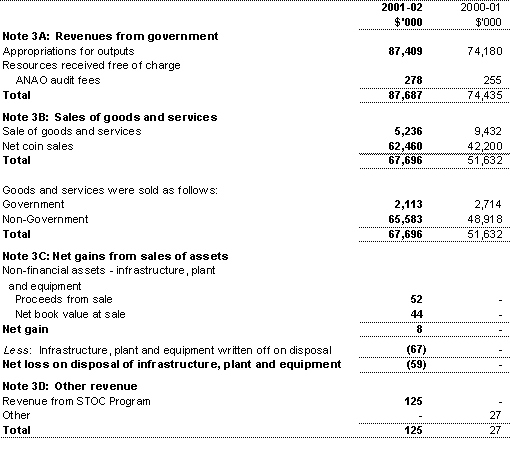
Note 4: Operating expenses
Note 5: Borrowing cost expenses

1 These comprise minimum lease payments only.
Note 6A: Consolidation
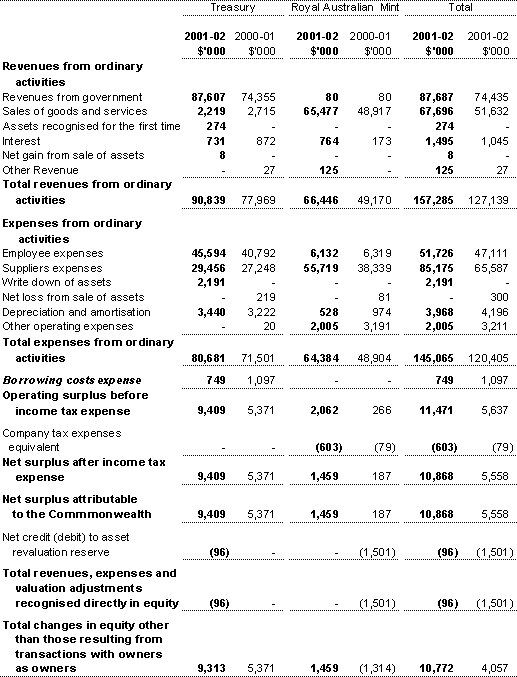
Note: The above amounts have been consolidated into the department's balances shown in these financial statements.
Note 6B: Consolidation (continued)
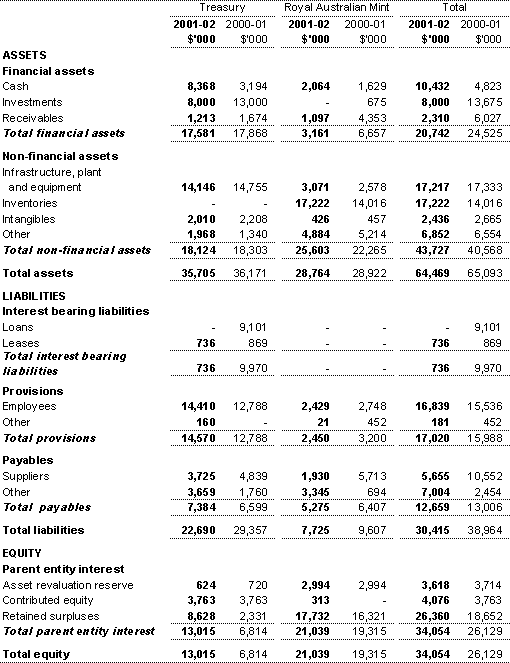
Note: The above amounts have been consolidated into the department's balances shown in these financial statements.
Note 7: Business operations

Note 8: Financial assets
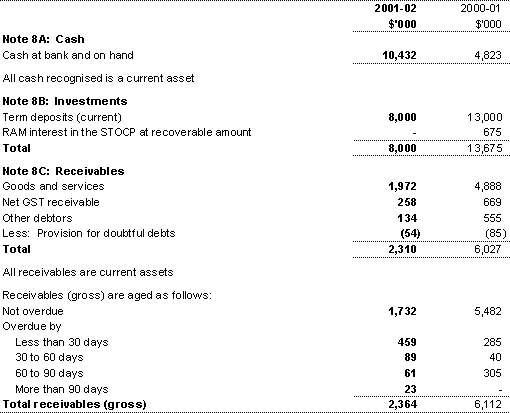
Note 9: Non-financial assets
Note 9A: Leasehold improvements

Note 9B: Infrastructure, plant and equipment
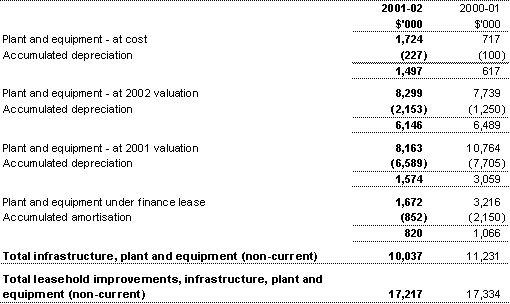
Note 9C: Intangibles

Note 9: Non-financial assets (continued)
Note 9D: Analysis of property, plant, equipment and intangibles
Table A: Reconciliation of the opening and closing balances of property, plant and equipment and intangibles
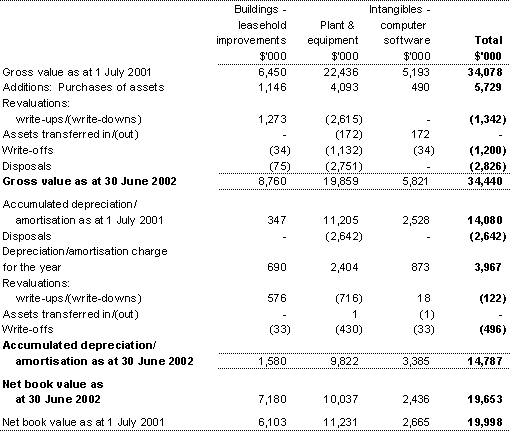
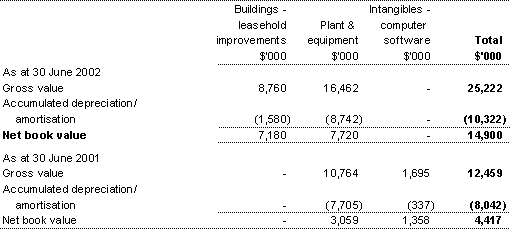
Note 9: Non-financial assets (continued)
Note 9D: Analysis of property, plant, equipment and intangibles (continued)
Table C: Assets held under finance lease
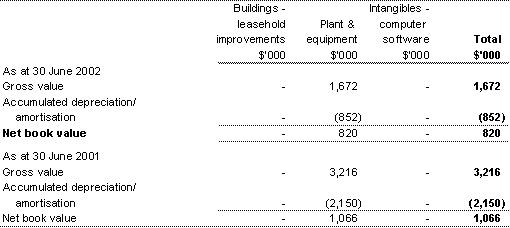
Table D: Assets under construction

Note 9E: Inventories

All departmental inventories are current assets.
Note 9: Non-financial assets (continued)
Note 9F: Other non-financial assets
All other non-financial assets are current assets
Note 9G: Company tax equivalent

Note 10: Interest bearing liabilities
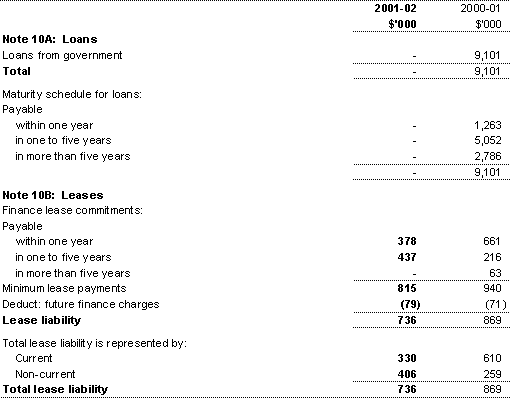
Finance leases exist in relation to certain major office equipment assets. The leases are non-cancellable and for fixed terms averaging three years, with a maximum of five years. The Department guarantees the residual values of all assets leased. There are no contingent rentals.
Note 11: Provisions
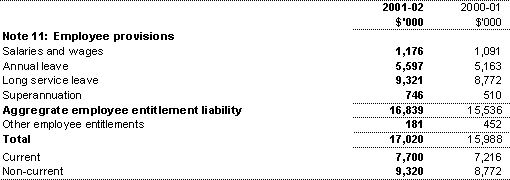
Note 12: Payables

All other payables are current liabilities.
Note 13: Equity

Transactional banking arrangements introduced from 1 July 1999 enabled agencies to manage their surplus cash balances and earn interest on them. Reviews are being conducted by the Department of Finance and Administration with each agency to determine whether interest earned to 30 June 2002 was consistent with the Government's budget-neutrality condition for the arrangements. The review in this agency indicated excess interest amounting to $1.145 million. However, as at the date of signing these financial statements, no decision had been made by the Government of the amount, if any, of the distribution of equity to be made to it by Treasury.
Note 14: Cash flow reconciliation
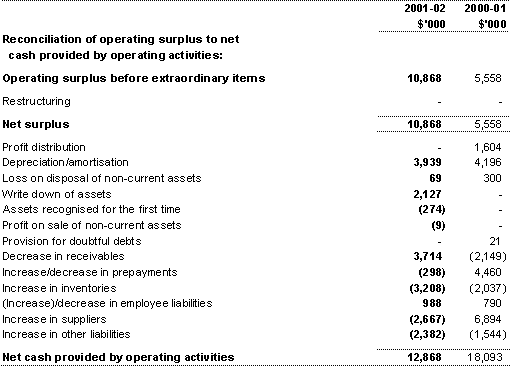
Note 15: Executive remuneration
Total remuneration includes actual salary, all allowances, employer superannuation component, vehicle costs and an estimate of the non-salary component of the Sen
ior Executive Service package.
For 2001-02, remuneration includes net accruals for annual leave and long service leave.
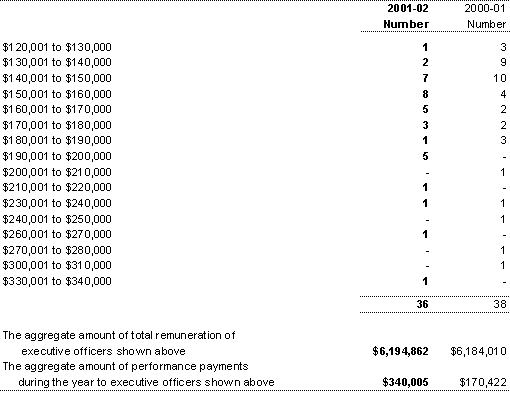
Note 16: Services provided by the Auditor-General

Note: the above amounts are exclusive of GST.
Note 17: Average staffing levels

Note 18: Act of grace payments, waivers and
amounts written off

Note 19: Financial instruments
Note 19A: Terms, conditions and accounting policies
|
Financial instruments |
Notes |
Accounting policies and methods |
Nature of underlying instruments |
|
Financial assets |
Financial assets are recognised when control over future economic benefits is established and the amount of the benefit can be reliably measured. |
||
|
Cash - at bank |
8A |
Deposits are recognised at their nominal amounts. |
The Department of the Treasury maintains bank accounts with the Reserve Bank of Australia for the administration of petty cash and for the receipt and payment of monies. The Royal Australian Mint maintains its own commercial accounts for the conduct of its business operations. |
|
Receivables for goods and services |
8C |
These receivables are recognised at the nominal amounts due less any provision for bad and doubtful debts. Collectability of debts is reviewed at balance date. Provisions are made when collection of the debt is judged to be less rather than more likely. |
Credit sales are normally on 30 day terms. |
|
Investments |
8B |
Deposits are recognised at their nominal amounts. Interest is credited to revenue as it accrues. |
The Department of the Treasury maintains term deposit accounts with the Reserve Bank of Australia. Rates have averaged 4.4 per cent for 2001-02. |
Note 19: Financial instruments (continued)
Note 19A: Financial instruments departmental (continued)
|
Financial instruments |
Notes |
Accounting policies and methods |
Nature of underlying instruments |
|
Financial liabilities |
Financial liabilities are recognised when a present obligation to another party is entered into and the amount of the liability can be reliably measured. |
||
|
Trade creditors and accruals |
12A |
Creditors and accruals are recognised at their nominal amounts, being the amounts at which the liabilities will be settled. Liabilities are recognised to the extent that the goods or services have been received (and irrespective of having been invoiced). |
Trade liabilities are normally settled on 30 day terms. |
|
Finance lease liabilities |
10B |
Liabilities are recognised at the present value of minimum lease payments at the beginning of the lease. The discount rates used are estimates of the interest rates implicit in the leases. |
At reporting date, the department had finance leases with terms averaging 3 years. The interest rate implicit in the leases averaged 9.06 per cent. The lease assets secure the lease liabilities. |
Note 19: Financial instruments (continued)
Note 19B: Interest rate risk - Departmental
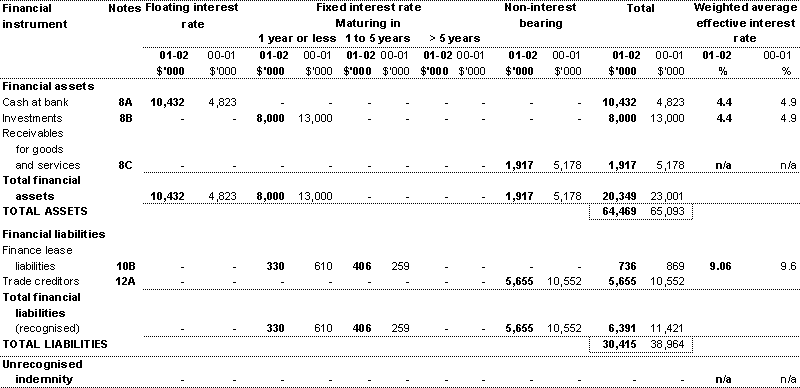
Note 19: Financial instruments (continued)
Note 19C: Net fair values of financial assets and liabilities
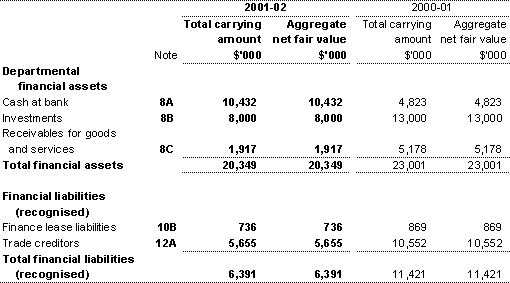
Note 19D: Credit risk exposures
The department's maximum exposures to credit risk at reporting date in relation to each class of recognised financial assets is the carrying amount of those assets as indicated in the Statement of Financial Position.
The department has no significant exposures to any concentrations of credit risk.
All figures for credit risk referred to do not take into account the value of any collateral or other security.
Note 20: Related party transactions
Note 21: Administered items
Note 21A - Revenue administered on behalf of government
as at 30 June 2002
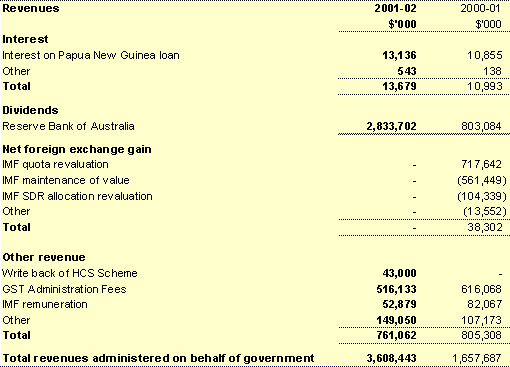
Note 21: Administered items (continued)
Note 21B: Expenses administered on behalf of government
as at 30 June 2002
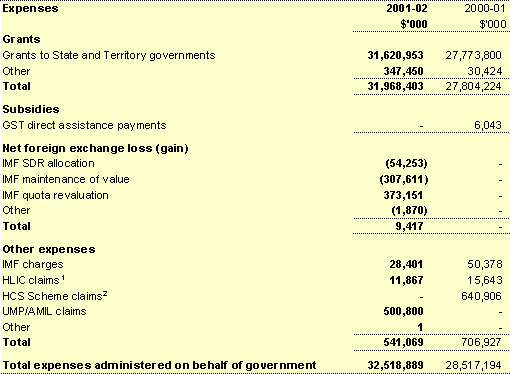
1 HLIC claims expenses include payments and management fees.
2 HCS Scheme claims expenses include payments and management fees.
Note 21: Administered items (continued)
Note 21C: Assets administered on behalf of government
as at 30 June 2002
Note 21: Administered items (continued)
Note 21D: Liabilities administered on behalf of government
as at 30 June 2002
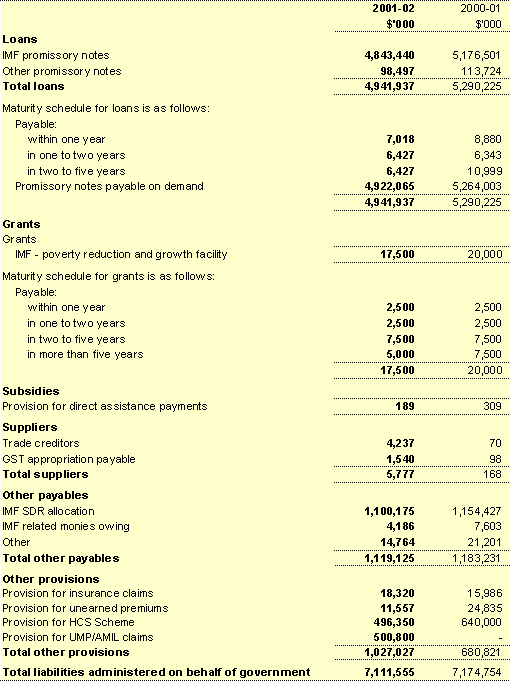
Note 21: Administered items (continued)
Note 21E: Administered cash flows
as at 30 June 2002

Note 21: Administered items (continued)
Note 21F: Administered commitments
as at 30 June 2002
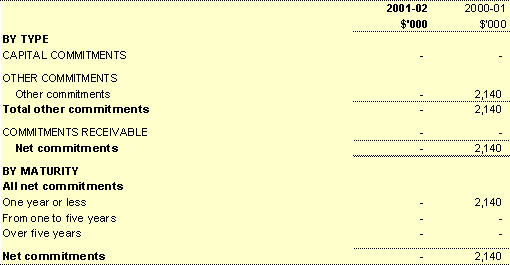
Note: All 2001-02 commitments are GST inclusive where relevant.
Note 21: Administered items (continued)
Note 21G: Administered contingencies
as at 30 June 2002

Administered remote contingencies are disclosed in Note 21H.
Unquantifiable administered contingencies
Contingent Gain
As beneficiary of the HIH Claims Support Trust, the Commonwealth will be entitled to the residual balance of the Trust, after the collection of recoveries and making of payments to claimants. Due to the inherent uncertainty regarding the measurement of the recoveries, it is not possible to quantify these amounts at this time.
Contingency
Following the decision on 29 April 2002 by the Boards of United Medical Protection Limited and Australasian Medical Insurance Limited (UMP/AMIL) to seek the appointment of a provisional liquidator, the Commonwealth committed to providing an indemnity to the provisional liquidator. The Commonwealth's commitments are set out in a Deed of Indemnity between the Commonwealth and UMP/AMIL and the provisional liquidator of UMP/AMIL that was approved by the NSW Supreme Court on 25 July 2002 (see Note 1.33).
Component (c) of the indemnity provides a guarantee to the provisional liquidator of UMP and AMIL to cover payments for incidents that occur between 29 April and 30 June 2002. The provisional liquidator will issue AMIL incident occurring policies to those doctors that were members of UMP on 29 April 2002 to meet this commitment. The full cost of these policies (administration and claims) will be met by the Commonwealth on the basis that incident-occurring cover is not the ordinary business of UMP/AMIL. No premiums will be charged for these policies.
The Commonwealth has commissioned an actuarial firm to determine the likely liability. The report was not available at the time of completion of audit cleared accounts.
Note 21: Administered items (continued)
Note 21H: Administered remote contingencies
The following borrowings have been guaranteed by the Commonwealth in respect of authorities within the Treasury portfolio:
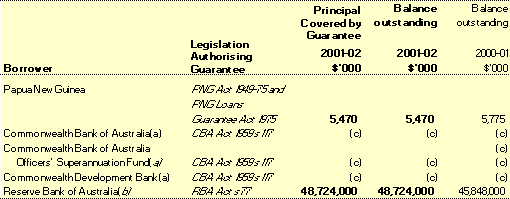
(a) In relation to the Commonwealth Bank of Australia, the Commonwealth Bank of Australia Officers' Superannuation Fund and the Commonwealth Development Bank, the Commonwealth guarantees all monies that are, or may at any time become, payable to a person other than the Commonwealth. Such guarantee will be progressively phased out following the government sell-down on 19 July 1996.
(b) In relation to the Reserve Bank of Australia, the Commonwealth guarantees all monies that are, or may at any time become, payable to a person other than the Commonwealth.
(c) At the finalisation of these statements this figure was not reliably measurable.
HIH Claims Support Scheme
The Commonwealth has a number of indemnities and guarantees in respect of the HIH Support Scheme.
UMP/AMIL
Following the decision on 29 April 2002 by the Boards of United Medical Protection Limited and Australasian Medical Insurance Limited (UMP/AMIL) to seek the appointment of a provisional liquidator, the Commonwealth committed to providing an indemnity to the provisional liquidator. The Commonwealth's commitments are set out in a Deed of Indemnity between the Commonwealth and UMP/AMIL and the provisional liquidator of UMP/AMIL that was approved by the NSW Supreme Court on 25 July 2002 (see Note 1.33).
Components (a) and (b) of the indemnity provides a guarantee to the provisional liquidator of UMP and AMIL to cover claims notified before 29 April 2002 that are finalised on or before 31 December 2002, and claims notified in the period 29 April 2002 to 31 December 2002.
These components of the indemnity allow for the ordinary business of UMP/AMIL to continue. The Commonwealth's indemnity for these elements will only be called on to the extent there is a shortfall in UMP/AMIL funds. The Government has announced that UMP members will be levied to pay for any Commonwealth liability that arises from claims and renewals from 1 July 2002 to 31 December 2002.
Note 21: Administered items (continued)
Note 21I: Administered consolidation

Note 21: Administered items (continued)
Note 21I: Administered consolidation (continued)

1HLIC claims expense includes claims payments and management fees.
2 HCS Scheme claims expense includes claims payments and management fees.
Note 21: Administered items (continued)
Note 21I: Administered consolidation (continued)
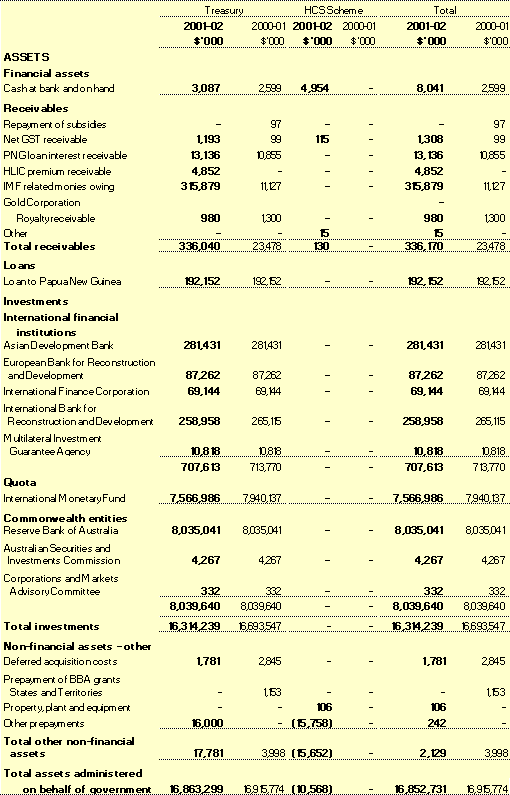
Note 21: Administered items (continued)
Note 21I: Administered consolidation (continued)
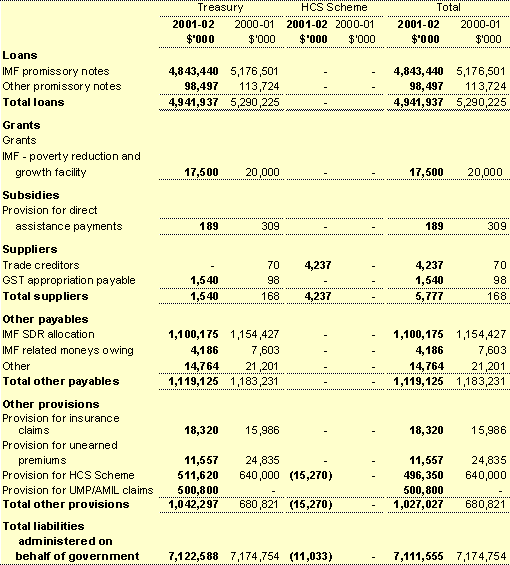
Note 21: Administered items (continued)
Note 21 J: Administered financial instruments
(a) Terms, conditions and accounting policies
|
Financial instruments |
Notes |
Accounting policies and methods (including recognition criteria and measurement basis) |
Nature of underlying instruments (including significant terms and conditions affecting the amount, timing and certainty of cash flows) |
|
Financial assets |
Financial assets are recognised when control over future economic benefits is established and the amount of the benefit can be reliably measured. |
||
|
Cash - at bank |
21C |
Deposits are recognised at their nominal amounts. |
The department maintains two bank accounts with a commercial bank for the purposes of administering mortgage insurance policies written by the Housing Loans Insurance Corporation (HLIC) up to 12 |
|
International Monetary Fund monies owing |
21C |
Amounts owing from the International Monetary Fund are credited to revenue as they accrue. |
Where the IMF's holdings of Australian dollars fall below a specified level, it pays remuneration on Australia's average remunerated reserve tranche position. The rate of remuneration is equal to the Special Drawing Rights (SDR) interest rate. This rate is then adjusted for burden sharing. Remuneration is calculated and paid at the end of the IMF's financial quarters. |
|
Loan receivable |
21C |
The loan to Papua New Guinea is measured at the amount lent. Collectability of amounts outstanding is reviewed at balance date. Provision is made for bad and doubtful loans where collection of the loan or part thereof is considered to be less rather than more likely. Interest is credited to revenue as it accrues. |
The loan to Papua New Guinea is made under contract with the principal and interest components of the loan to be repaid in full by 30 June 2006. The interest rate on the loan is fixed at 7.05 per cent per annum. |
Note 21: Administered items (continued)
Note 21 J: Administered financial instruments (continued)
(a) Terms, conditions and accounting policies (continued)
|
Financial instruments |
Notes |
Accounting policies and methods |
Nature of underlying instruments |
|
Financial liabilities |
Financial liabilities are recognised when a present obligation to another party is entered into and the amount of the liability can be reliably measured. |
||
|
Grant liabilities |
21D |
Grants are recognised as liabilities and expensed in the year in which the grant agreements are made. |
This represents Australia's contribution to the Poverty Reduction and Growth Facility (PRGF), previously known as the Enhanced Structural Adjustment Facility (ESAF), of the IMF. The PRGF will enable the IMF to provide concessional funding to support medium term macroeconomic adjustment and structural reforms in low income countries. The PRGF will assist Australia to promote its international economic and aid interests with developing countries in the Asian region. Australia's contribution involves $30 million to be paid in annual instalments of $2.5 million over a 12-year period. |
Note 21: Administered items (continued)
Note 21 J: Administered financial instruments (continued)
(a) Terms, conditions and accounting policies (continued)
|
Financial instruments |
Notes |
Accounting policies and methods |
Nature of underlying instruments |
|
International Monetary Fund (IMF) Special Drawing Right (SDR) allocation liability |
21D |
This liability is recognised as a monetary liability. It is valued at the Australian dollar equivalent of its liability in Special Drawing Rights. Interest expense is recognised as it accrues. |
The SDR allocation liability reflects the current value in Australian dollars of the department's liability to repay to the IMF Australia's cumulative allocations of SDRs. Interest is payable to the IMF in relation to the amount of SDR holdings that are below Australia's net cumulative allocations. |
|
Loans - promissory notes |
21D |
The promissory notes are measured at nominal face value. |
The Department has on issue promissory notes to the International Monetary Fund (IMF), the International Bank for Reconstruction and Development (IBRD), the Asian Development Bank (ADB) and European Bank for Reconstruction and Development (EBRD). These promissory notes are in relation to undrawn paid-in capital subscriptions. Promissory notes to the value of $4.92 billion do not possess established drawdown schedules. The promissory notes are non-interest bearing. |
Note 21: Administered items (continued)
Note 21 J: Administered financial instruments (continued)
(b) Interest rate risk
The Department's exposure to interest rate risk and the effective weighted average interest rate for each class of financial assets and financial liabilities is set out below.
Note 21: Administered items (continued)
Note 21 J: Administered financial instruments (continued)
(b) Interest rate risk (continued)
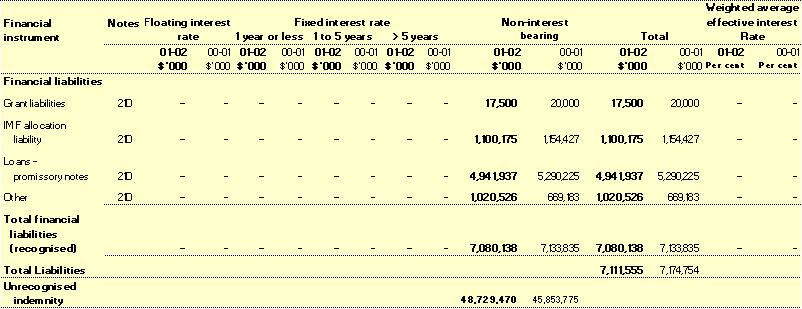
Note 21: Administered items (continued)
Note 21 J: Administered financial instruments (continued)
(c) Net fair values of administered financial assets and liabilities
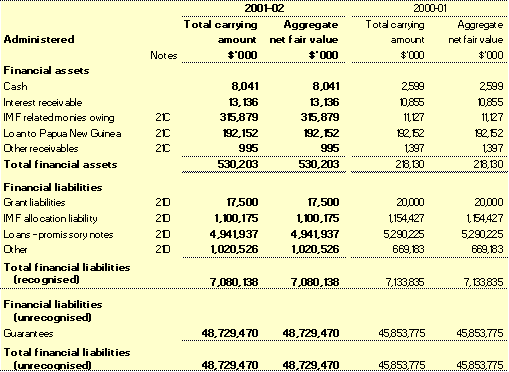
(d) Credit risk exposures
The administered maximum exposures to credit risk at reporting date in relation to each class of recognised financial assets is the fair value of those assets as indicated above.
Note 22: Appropriations
Note 22A: Appropriation Acts (No. 1/3) 2001-02
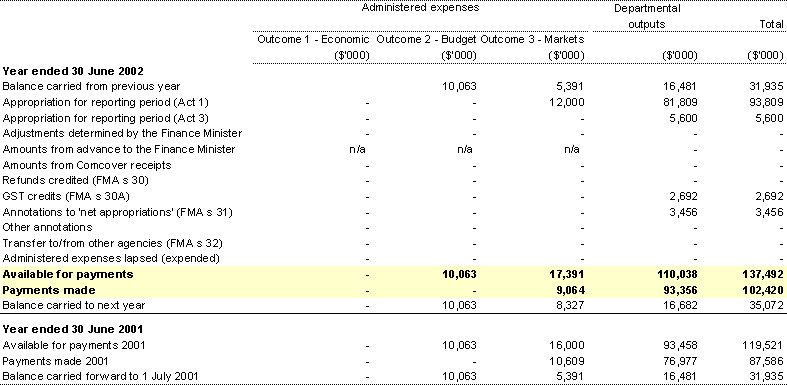
FMA = Financial Management and Accountability Act 1997
Act 1 = Appropriation Act (No.1) 2001 - 2002
Act 3 = Appropriation Act (No.3) 2001 - 2002
Note 22: Appropriations (continued)
Note 22B: Appropriation Acts (No. 2/4) 2001-02
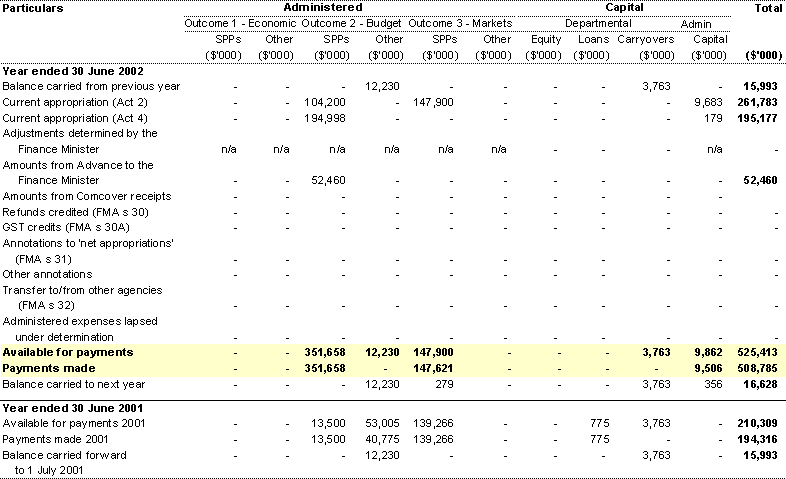
Act 2 = Appropriation Act (No.2) 2001 - 2002
Act 4 = Appropriation Act (No.4) 2001 - 2002
Note 22: Appropriations (continued)
Note 22C: Special Appropriations (Unlimited Amount)
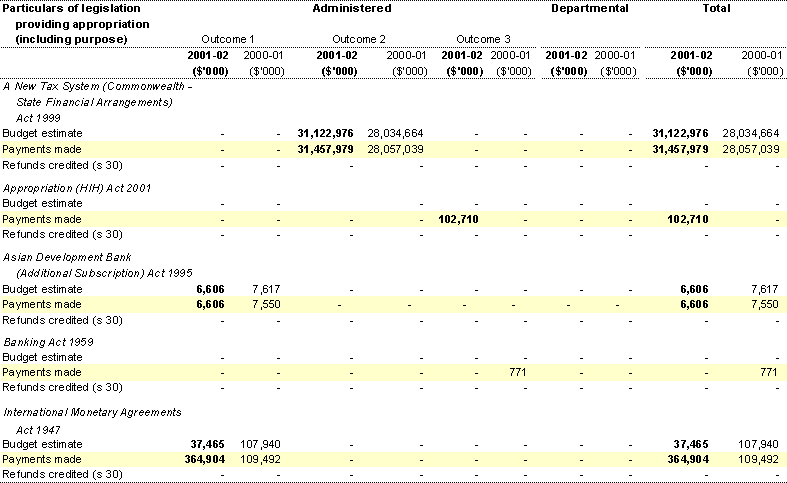
Note 22: Appropriations (continued)
Note 22C: Special Appropriations (Unlimited Amount) (continued)

The amount of the appropriation that lapsed is based on the amount to be determined by the Finance Minister under the annual appropriation Acts, to be the administered expenses by the Department in the current year.
Note 23: Special accounts
Other trust moneys
Legal authority
Financial Management and Accountability Act 1997, section 20.
Purpose
For the receipt of moneys temporarily held in trust for other people.

Note 23: Special accounts (continued)
Royal Australian Mint and Coinage Trust
Legal authority
Financial Management and Accountability Act 1997, section 20.
Purpose
(a) Payment of goods and services, salaries and other expenses incurred for activities entered into by the Royal Australian Mint and approved by the Treasurer.
(b) Repayment of capital funds and payment of moneys in excess of requirements to Consolidated Revenue Fund.


Note 23: Special accounts (continued)
Ministerial Council on Consumer Affairs
Legal authority
Financial Management and Accountability Act 1997, section 20.
Purpose
To receive funds from member bodies to provide secretariat support and funding for agreed MCCA projects.


Note 23: Special accounts (continued)
Advisory Panel for Marketing in Australia of Infant Formula
Legal authority
Financial Management and Accountability Act 1997, section 20.
Purpose
To meet the administrative costs of APMAIF, a non-statutory body that advises government on the marketing in Australia of infant formulas: Manufactures and Importers Agreement 1992.

Note 23: Special accounts (continued)
Commonwealth Consumer Affairs Advisory Council
Legal authority
Financial Management and Accountability Act 1997, section 20.
Purpose
To fund projects on behalf of the Parliamentary Secretary to the Treasurer's advisory council on consumer issues.


Note 24: Special public money
Comcare
Legal authority
Financial Management and Accountability Act 1997, section 20.
Purpose
Moneys held in trust and advanced to the department by Comcare for the purpose of distributing compensation payments made in accordance with the Safety Rehabilitation and Compensation Act 1998.

Revenue replacement payments
Legal authority
States Grants (General Purposes) Act 1994, schedule 5.
Purpose
For the payment of moneys to the States and Territories in connection with constitutionally invalid business franchise fees.

Note 24: Special public money (continued)
Lloyds deposit trust fund
Legal authority
Insurance Laws Amendment Act 1998, schedule 2.
Purpose
To meet the costs of the judicial management and wind-up in the event the company ceases to trade.

Investments
The balance of investments at 30 June 2002 includes the following investments held in the corporate name of the Treasurer of the Commonwealth pursuant to subsection 93(1) of the Insurance Act 1973 on behalf of the Trust.

Note 24: Special public money (continued)
Trustee companies (ACT) deposits trust fund
Legal authority
Trustee Companies Act 1947, subsection 10(1).
Purpose
For the purpose of administering the Trustee Companies Act 1947 in relation to trustee companies.

Investments
The balance of investments at 30 June 2002 includes the following investments held in the corporate name of the Treasurer of the Commonwealth pursuant to subsection 10(1) of the Trustee Companies Ordinance 1947 on behalf of the Trust.

Note 25: Reporting of outcomes
Note 25A - Total cost/contribution of outcomes (whole-of-government)

Note 25B - Major departmental revenues and expenses by output group

Note 25C - Major classes of departmental assets and liabilities by output group
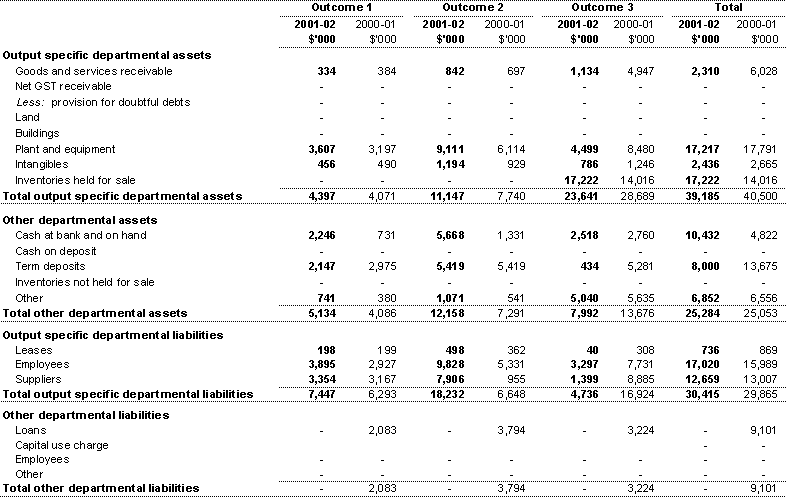
Note 25D - Major classes of administered revenues and expenses by outcome
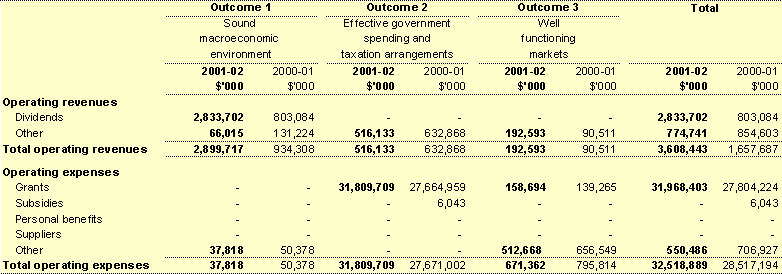
Note 25E - Major classes of administered assets and liabilities by output group

